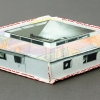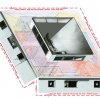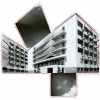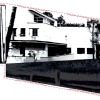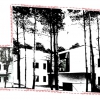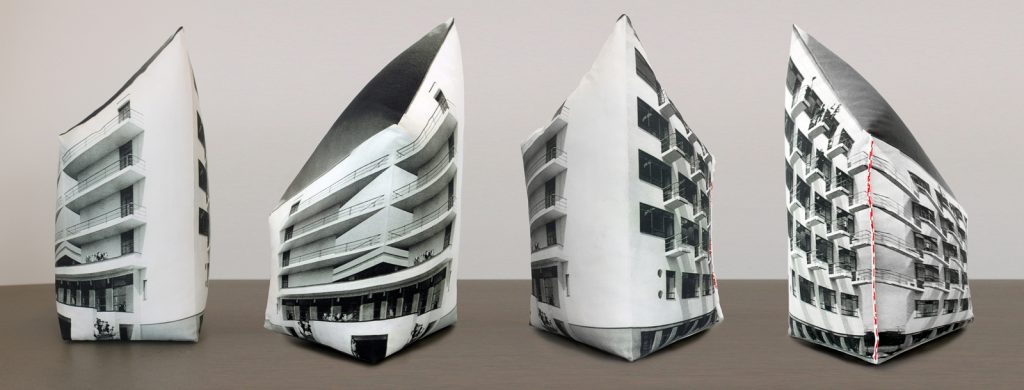
![]() Three different models of textile bauhaus.houses: digital print on fabric 2006; Woven Object: sisal and cotton , handwoven , wood 1989
Three different models of textile bauhaus.houses: digital print on fabric 2006; Woven Object: sisal and cotton , handwoven , wood 1989
Acc Galerie : Exhibition ‘ Other Places Statements to Weimar – Linz ‘ Weimar, Germany 2006
The installation created by the artist consists of two large scale elements dominating the space comprising of a sizeable woven object and three printed fabric panels. The panels depict images of Bauhaus buildings in Weimar and Dessau. They are delineated by dress pattern lines, so they can be cut out and assembled into three dimensional objects of the buildings.
The artist employes her own medium of textile and in doing so she combines the historical element of textile art as applied at the Bauhaus by the female artists working there using this field of study within the architecture. This is a homage to those female Bauhaus artists.
By using fabric as a material to create miniature architecture, Walter Gropius’s dominant buildings that loomed so largely over the various craft disciplines that developed and blossomed at the Bauhaus – are reverted into these very materials that were used by the textile artists working there. The initial inspirations and architectural elements of buildings chosen by the artist were the Musterhouse am Horn in Weimar, the Atelierhouse and one of the Meisterhouses in Dessau. Also used in the print were images of students and artists of the weaving courses at Weimar and Dessau. The idea of architecture in fabric by the yard, to be cut off the roll. These images are not only symbols and interchangeable elements of current and future Bauhaus architecture, they come to symbolize the important transformative influences of textile art and design from that time into the present.
The woven object in the exhibit is one of the last handwoven tapestries executed by the artist. It is a symbol of an autographic development in reference to the traditional commissioned tapestry that was woven after designs and maquettes drawn by artists. As such the tapestry becomes a symbol for letting go by the artist in the medium of a commissioned handwoven tapestry. This is also the starting point of Riedl’s unique personal voice in the use of different soft materials. This transforms the artist as their own creator in the medium, not simply the conduit to translate art into a tapestry imagery. The same history of development has happened at the Bauhaus during its time.
Photo of Woven Object by Christian Schepe


